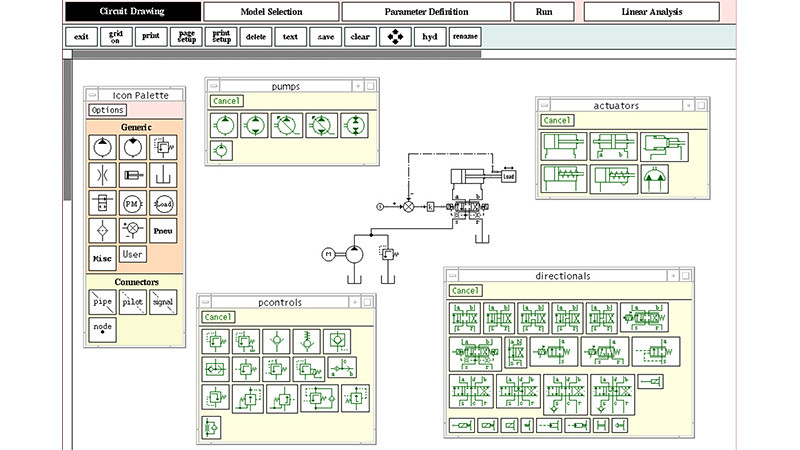The Centre for PTMC uses a number of leading software titles for research and consultancy, but some of our work covers specialised areas for which existing software is either not suitable or needs to be extended. In some cases, the tools we create to help us with our projects mature into standalone products that are available to our cooperators and customers and we'd like to introduce these here.
Centre for Power Transmission & Motion Control software
We develop software that helps us and industry lead research in fluid-borne noise, fluid circuit simulation and dynamic simulation of multi-physics systems.
Fluid-borne noise
Today software is readily available to simulate the dynamics of mechanical systems. The prediction and analysis of fluid-borne noise is less established. To close this gap, Dr Johnston at the Centre developed two powerful software packages, FBN and Prasp.
FBN software for measuring fluid-borne noise
We have developed a methodology to measure the noise-related characteristics of a wide range of fluid power components.
Prasp Matlab/Simulink toolbox software for modelling fluid-borne noise
Our pressure ripple analysis software package (Prasp) is a MATLAB/Simulink® toolbox that models fluid-borne noise (FBN) characteristics of hydraulic circuits.
Developing software has a long tradition within the Centre. Arguably the first milestone was the development of tools for the "Computer Aided Design of Fluid Power Systems" in 1975, sponsored by the Ministry of Defence. This research then lead into further work, culminating in the "Hydraulic Automatic Simulation Package", HASP. Through subsequent improvements and additions, HASP changed into what is probably the Centre's best-known software title: Bathfp
Bathfp is a high-performance interactive simulation package for dynamic systems, especially - as the name implies - fluid power systems. Read on to find out what made Bathfp special and how it lives on to this day.
Bathfp

Simulating hydraulic systems poses some mathematical challenges that are much more apparent in them than in purely mechanical systems. The dominant challenge is the numerical stiffness of the differential equations that describe the dynamic system behaviour. Put simply, a numerically stiff problem has several possible results, some of which vary very fast and others change very slowly. Special solvers are available to bridge this gap while maintaining numerical efficiency, meaning they do not do an excessive amount of iterative calculations just to be "on the safe side". Bathfp's solver quality and the automatic solver selection and -parametrisation was a breakthrough in the late 1980s and for a given CPU load, allowed the simulation of larger, more dynamic systems.
While Bathfp's heart was the novel simulation approach to fluid power systems, it was clear from the beginning that a useful tool would have to allow to incorporate mechanical systems such as masses, springs and dampers so that the crucial interaction could be investigated. For much the same reason, Bathfp allowed the implementation of closed-loop control in simulation, such as hydraulic systems in position control, bringing two cornerstones of the Centre's expertise together.
Will Richards, Bathfp's software developer, realised the commercial potential and in 1993 joined the engineering software company Imagine and commercialised Bathfp under the name Amesim. Imagine then got bought by LMS International, who are now part of Siemens. Siemens Simcenter Amesim remains a leading software tool. The Centre maintains a cooperation with Siemens in our work, especially our CPD courses and uses Amesim for several of our projects.
Contact us
If you have any questions about our software and how you can use it, please get in touch.